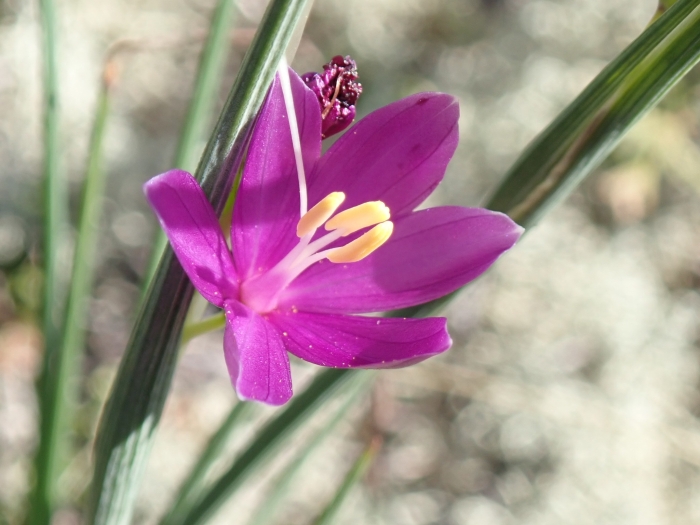Douglas’ Grasswidow
(Olsynium douglasii)
Douglas’ Grasswidow (Olsynium douglasii)
/
/

John Brew
CC BY 4.0
Image By:
John Brew
Recorded By:
Copyright:
CC BY 4.0
Copyright Notice:
Photo by: John Brew | License Type: CC BY 4.0 | License URL: http://creativecommons.org/licenses/by/4.0/ | Rights Holder: John Brew | Publisher: iNaturalist | Date Created: 2019-03-27T17:47:55Z |



















































Estimated Native Range
Summary
Olsynium douglasii, commonly known as Douglas’ Grasswidow, is a perennial herb that is deciduous or semi-deciduous. It is native to moist meadows, grasslands, and open woodlands of the Pacific Northwest, including the Western United States. This plant typically grows 10–40 cm (3.9–15.7 in) tall and features slender, linear leaves that are 10–30 cm (3+7⁄8–11+3⁄4 in) long and 1.5–3 mm broad. The flowers are particularly showy, bell-shaped to star-shaped, 15–25 mm long, with six vibrant purple tepals that bloom in early spring, providing one of the first signs of color in the landscape.
Douglas’ Grasswidow is valued for its early spring flowers, which can add a splash of color to rock gardens, native plant gardens, and borders. It is also suitable for naturalized areas. While it thrives in full sun to part shade, it prefers consistently moist soils with good drainage. It is relatively low maintenance but benefits from being planted in an area that mimics its native moist meadow conditions. Although not common, it can be susceptible to root rot if drainage is poor.CC BY-SA 4.0
Douglas’ Grasswidow is valued for its early spring flowers, which can add a splash of color to rock gardens, native plant gardens, and borders. It is also suitable for naturalized areas. While it thrives in full sun to part shade, it prefers consistently moist soils with good drainage. It is relatively low maintenance but benefits from being planted in an area that mimics its native moist meadow conditions. Although not common, it can be susceptible to root rot if drainage is poor.CC BY-SA 4.0
Plant Description
- Plant Type: Herb
- Height: 0.3-1 feet
- Width: 0.6-1 feet
- Growth Rate: Moderate
- Flower Color: Purple, Pink
- Flowering Season: Spring
- Leaf Retention: Deciduous
Growth Requirements
- Sun: Full Sun, Part Shade
- Water: Medium
- Drainage: Medium, Fast
Common Uses
Low Maintenance, Rock Garden, Showy Flowers
Natural Habitat
Native to moist meadows, grasslands, and open woodlands of the Pacific Northwest
Other Names
Common Names: Douglas’ Blue-Eyed-Grass, Douglas’ Grass-Widow, Douglas’ Purple-Eyed-Grass, Satinflower, Olsynie De Douglas, Douglas’ Olsynium
Scientific Names: , Olsynium douglasii, Sisyrinchium douglasii, Sisyrinchium grandiflorum, Olsynium grandiflorum, Eriphilema grandiflora,
GBIF Accepted Name: Olsynium douglasii (A.Dietr.) E.P.Bicknell